The Lakota phrase, Mni Wiconi, Water is Life, has inspired a Native Nations protest against the recent approval and ongoing construction of the Dakota Access Fracked Oil Pipeline (DAPL), that threatens all communities and ecosystems downstream. Following the October 27 military-style assault by police and DAPL security personnel on unarmed water protectors trying to stop the desecration of sacred burial sites, the construction nears the shores of Lake Oahe, the dammed-section of the Missouri River serving as water supply for the Standing Rock Sioux Tribe and 18 million others.
Sign This Petition – Stop Construction of the Dakota Accesss Pipeline
Learn more about DAPL and current needs of the camp at http://sacredstonecamp.org
DONATE to the legal defense fund here: http://fnd.us/d19fAf?ref=sh_25rPQa
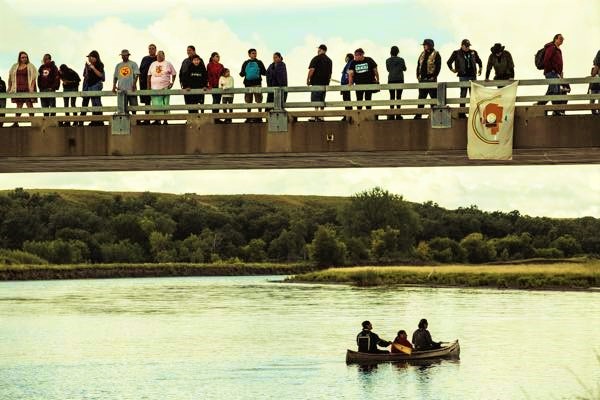

Tribal Gathering Against Dakota Access Faces Aggressive State Repression and Media Manipulation
From Camp of the Sacred Stones
The historic gathering of tribes from across the continent in opposition to the Dakota Access pipeline continues in the face of aggressive state repression and media manipulation. On August 19, North Dakota Governor Dalrymple declared a State of Emergency in order to make additional state resources available to “manage public safety risks associated with the protest.” Dalrymple has complained of “outside agitators” responsible for “hundreds of criminal acts,” and called on federal officials to help. But LaDonna Allard, Director of the Camp of the Sacred Stone, says, “The gathering here remains 100% peaceful and ceremonial, as it has from day one. We are standing together in prayer. No firearms or weapons are allowed. Why is a gathering of Indians so inherently threatening and frightening to some people?”
STORY: Activists Ask Obama to Stop Dakota Access Pipeline at Beverly Hills Fundraiser
[vimeo clip_id="189876726" width=600 height=338 ]
Update Nov 2: Dakota Access Construction Is Almost at the Missouri River


The Texas-based company building the [$3.8 billion] Dakota Access pipeline, Energy Transfer Partners [in conjunction with Canadian company Enbridge Energy Partners], calls the project a major step toward the United States’ [and Canada’s, I guess] weaning itself off foreign oil. The company says the nearly 1,170-mile buried pipeline will infuse millions of dollars into local economies and is safer than trucks and train cars that can topple and spill and crash and burn.
But the people who stood at the gates of a construction site where crews had been building an access road toward the pipeline viewed the project as a wounding intrusion onto lands where generations of their ancestors hunted bison, gathered water and were born and buried, long before treaties and fences stamped a different order onto the Plains. — New York Times
httpvh://youtu.be/kuZcx2zEo4k
Helicopters, Dogs and Mace the Last Refuge of Dakota Access Pipeline Cowards Digging up Sacred Sites – “We’re Not Leaving!” – Democracy Now
More than 570,000 barrels of Bakken crude oil will pass through the pipeline daily, along with 245,100 metric tons of carbon daily, or enough carbon to combust the planet to oblivion. The pipeline would span 200 water crossings, and in North Dakota alone would pass through 33 historical and archaeological sites. Enbridge just bought the Dakota Access pipeline, noting that the proposed Sandpiper route—Minnesota’s 640,000 barrel per day Bakken line—is now three years behind schedule. — Winona LaDuke
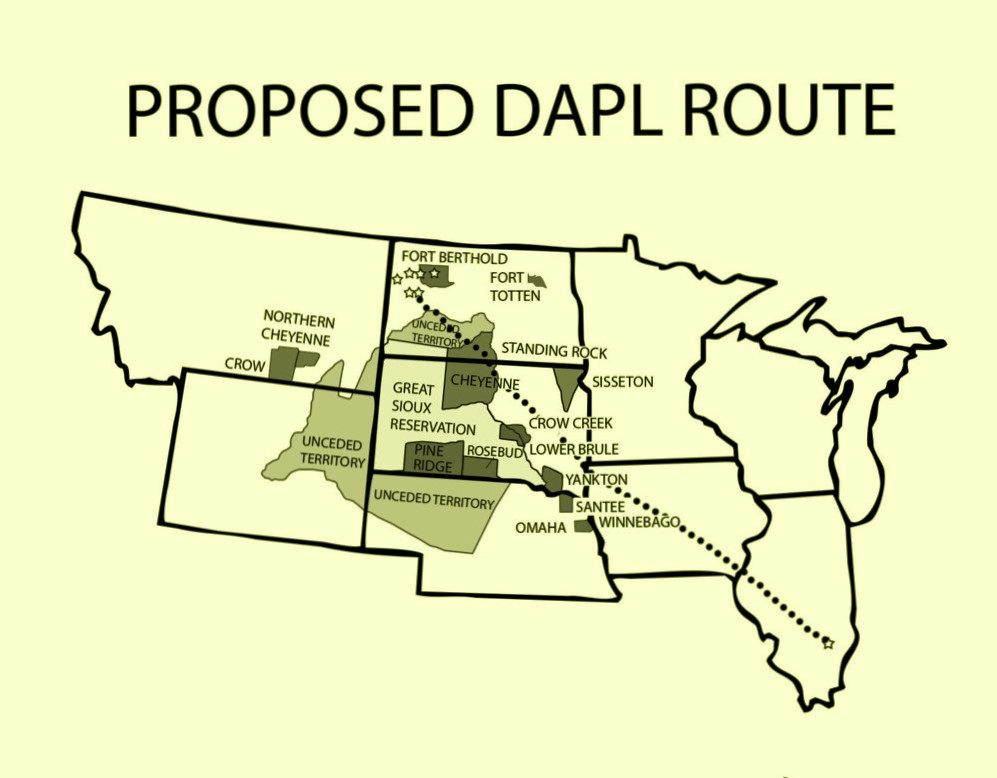

On Monday, August 22, the Morton County Board also declared a State of Emergency in order to access the funds released by the Governor — to request overtime wages, extra equipment, and money to reimburse other law enforcement agencies sending resources. This decision relies on a false narrative of violence put forth by Morton County Sheriff Kyle Kirchmeier, who last week announced outrageous, unsubstantiated claims of “pipe bombs” and gun violence at the protest site. Dallas Goldtooth, Keep It In The Ground Campaign Organizer for the Indigenous Environmental Network says, “These are dangerous statements by Sheriff Kirchmeier and only foster greater resentment between local native and non-native residents. Furthermore, we have women, children and elders in our camp; and because of the Sheriff’s false narrative those families now have to fear for their own safety.”
Forced into the reservation life, the Lakota attempted to stabilize their society, until the dams came. The 1944 Pick Sloan project flooded out the Missouri River tribes, taking the best bottom lands, from the Mandan, Hidatsa, and Arikara, the Lakota and Dakota. Over 200,000 acres on the Standing Rock and Cheyenne River reservations in South Dakota were flooded by the Oahe Dam itself, forcing not only relocation, but a loss of the Lakota world. The Garrison, Oahe, and Fort Randall dams created a reservoir that eliminated 90 percent of timber and 75 percent of wildlife on the reservations. That is how a people are made poor. — Winona LaDuke
…[T]he fact is, is that there are now more lawsuits than active drilling rigs out there, you know, because there was such a big push to develop all this oil in the Bakken, basically bust up the bedrock of Mother Earth, put all those chemicals in it, look the other way and pretend like things are going swimmingly out in North Dakota. So, North Dakota has got this landlocked oil. They’re taking a beating on it right now. There is an 85 percent drop in active drilling rigs in the Bakken. — Winona LaDuke on Democracy Now
httpvh://youtu.be/kooD44norew
Native Activist Winona LaDuke: Pipeline Company Enbridge Has No Right to Destroy Our Future – Deomocracy Now
Meanwhile, the main road accessing the camp, Highway 1806, has been shut down by authorities since Friday. A military-style checkpoint is established at Fort Lincoln, where motorists are constantly surveilled with cameras and interrogated about their activities. Identities are recorded and anyone suspected of traveling to the protest site is turned away and forced to travel a long detour. These checkpoints violate constitutional protections and international law by restricting freedom of movement without justification. They further isolate a people who are already extremely geographically and politically isolated. At the same time, police presence has been amplified on the reservation and many have been racially profiled and harassed for no reason.
STORY : Big Oil and Gas Resistance in BC: The Unist’ot’en Call to the Land
The Standing Rock Sioux Tribe (SRST) filed a lawsuit against the Army Corps of Engineers on July 27 to stop the pipeline that would cross under the Missouri River [Called Mnisose, a great swirling river, by the Lakota], the reservation’s sole source of water. The corps approved the pipeline last month, but the tribe argues they were not properly consulted, and that cultural and historical sites would be destroyed during construction.
Judge James E. Boasberg from the United States District Court for the District of Columbia said he will make a decision about the $3.7 billion Dakota Access Pipeline on or before September 9. — PBS NewsHour
Jon Eagle Sr., SRST’s tribal historic preservation officer, explained the historic and cultural significance of the site:
The land between the Cannonball River and the Heart River is sacred. It’s a historic place of commerce where enemy tribes camped peacefully within sight of each other because of the reverence they had for this place. In the area are sacred stones where our ancestors went to pray for good direction, strength and protection for the coming year. Those stones are still there, and our people still go there today.
httpvh://youtu.be/6hyTPZ9101s
Police Cracking Down On Dakota Access Pipeline Protesters – The Young Turks
On Monday, North Dakota’s Homeland Security Director ordered the removal of state-owned medical trailers and water tanks from the camp, citing reports of unlawful activity and fears that the equipment is unsafe. Tara Houska, National Campaigns Director for Honor the Earth, says, “It is deeply ironic that the Governor would release emergency funds under the guise of public health and safety, but then remove the infrastructure that helps ensure health and safety in the camp. This is nothing but repression of our growing movement to protect our water and future generations.”
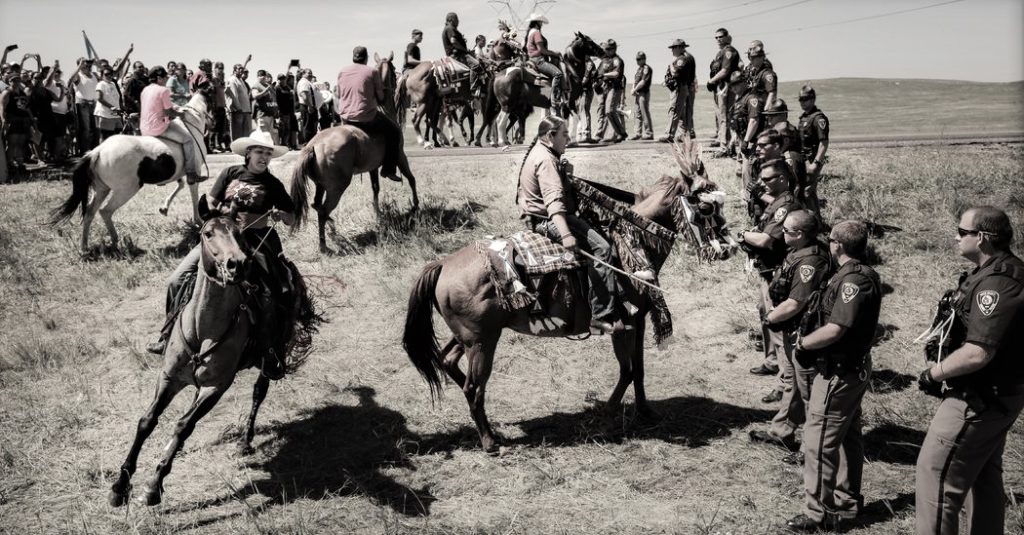

The North Dakota Highway Patrol and the Federal Bureau of Investigation also announced they are investigating two incidents of “laser strikes” aimed at surveillance aircraft patrolling above the camp. “Why launch a federal investigation into a laser pointer instead of asking what right the US government has to fly surveillance planes over sovereign nations in the first place?” said Houska.
[vimeo clip_id="179279029" width=600 height=338 ]Jacobin Magazine: From the 1890 Wounded Knee Massacre onwards, the Lakota, and indeed Native Americans throughout the nation, have engaged in an endless struggle to protect their land, resources, and people. They fought the federal government’s efforts to dismantle reservations, during which the government sold off supposedly surplus Indian land to white settlers for pennies on the dollar. This practice continued until 1934.
They have also had to fight to prevent their land from becoming a dumping ground for America’s refuse. Most notably, the Navajo have suffered the terrible effects of nuclear waste.
These issues came to a head in the 1970s, when the American Indian Movement, drawing on the language of Black Power and a heritage of resistance, occupied Wounded Knee and Alcatraz and brought national attention to the reservations’ plight.
As Hunkpapa Lakota medicine man Sitting Bull once stated: “We have now to deal with another race–small and feeble when our fathers first met them, but now great and overbearing. Strangely enough they have a mind to till the soil and the love of possession is a disease with them. These people have made many rules that the rich may break but the poor may not. They take their tithes from the poor and weak to support the rich and those who rule.”
Tribal Woman Explains Why They Defend Water & Oppose the Dakota Access Pipeline — Unicorn Riot
[vimeo clip_id="161330296" width=600 height=338 ]“We don’t want this black snake within our Treaty boundaries,” said Standing Rock Sioux Tribal Chairman Dave Archambault II. “We need to stop this pipeline that threatens our water. We have said repeatedly we don’t want it here. We want the Army Corps to honor the same rights and protections that were afforded to others, rights we were never afforded when it comes to our territories. We demand the pipeline be stopped and kept off our Treaty boundaries.” — Indian Country Today Media Network
In April 2016, a caravan of over 200 supporters, led by forty riders on horseback, left Fort Yates, ND, for a thirty mile trek to the camp located just north of Cannonball. — Unicorn Riot
Updated 4 November 2016

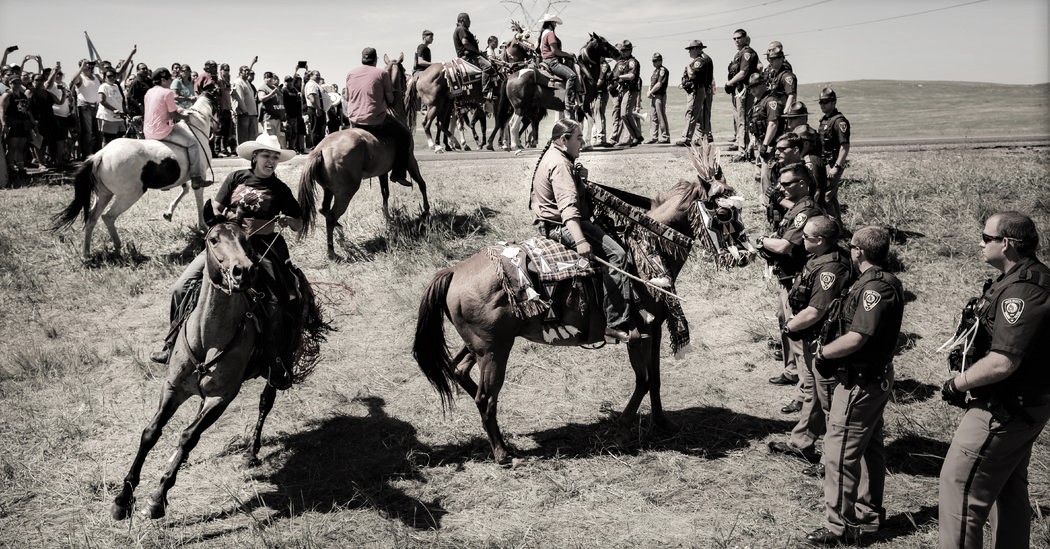





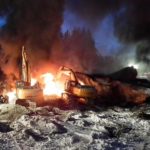






Pingback: Leonard Peltier Survives in the Spirit of Crazy Horse | WilderUtopia.com
Pingback: Native Prayer: Army Corps Must Stop Dakota Access | WilderUtopia.com
Pingback: 2017 Rose Parade: Up With the People, Down with the Pipeline | WilderUtopia.com
Pingback: Youth-Led Activism: Inspiring Change and Building Community | WilderUtopia.com